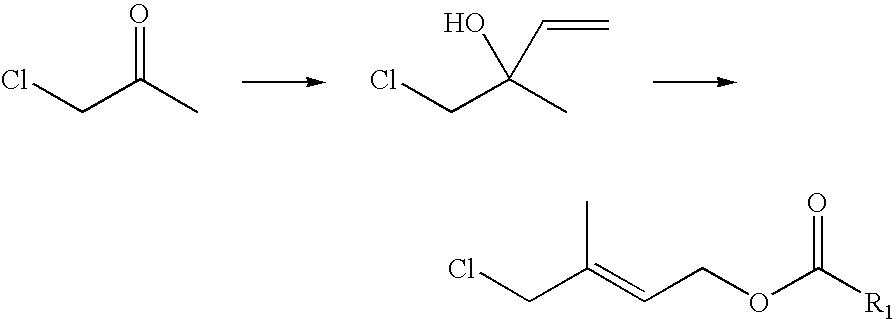Method of manufacturing 1-chloro-2-methyl-4-acyloxy-2-butene derivatives
a technology of acyloxy-2-butene and acyloxy-2-butene, which is applied in the preparation of carboxylic acid halide, chemistry apparatus and processes, and organic chemistry, etc., can solve the problems of low yield, low content of products obtained in this process, and low content of products
- Summary
- Abstract
- Description
- Claims
- Application Information
AI Technical Summary
Benefits of technology
Problems solved by technology
Method used
Image
Examples
example 1
Preparation of a mixture of 1-chloro-2-hydroxy-2-methyl-3-butylene and 1-chloro-2-methyl-4-hydroxy-2-butylene
[0031]A 500 mL three neck flask equipped with a thermometer and a solid feed inlet was charged with 68 g (1 mole) of isoprene, 100 mL H2O, 0.5 g hydroquinone (polymerization inhibitor), then put it into a cooling bath. The temperature was kept at 0-5° C. 58 g (0.25 moles) trichlorominocyanuric acid (90% available chlorine) were added with stirring within about 1 hour, and stirring continued for another 1 h at the same temperature. Then the reaction mixture was filtered, and the filter cake washed with 15 mL H2O and dried. The weight of the obtained white solid was 31 g (0.24 moles). The filtrates were combined. The organic layer was separated and the unreacted isoprene recovered under reduced pressure below 41° C. to yield 90 g of the crude title products. GC analysis indicated the total content of crude product was 92.5%, and the yield was 92.1%. The recovered unreacted isop...
example 2
Preparation of 1-Chloro-2-methyl-4-acetyloxy-2-butene by esterification and rearrangement
[0034]A 250 three neck flask was charged with 80 g acetic anhydride (0.78 moles) and 63 g crude product (content 92.5%, 0.48 moles) obtained in upper step; 1 g para-toluenesulfonate added under stir, then heated to 60° C. and stir for 5 h. Cooled to room temperature, 100 mL H2O added and stir 10 min, stratified, waste water was removed. Organic layer washed with 100 mL H2O, stratified, 63 g crude product was obtained (content 90% by G.C.), after rectification a colorless transparency liquid 55 g (content 93.5% by G.C.) obtained, yield 66%.
[0035]GC-MS(m / e): 127, 102, 84, 67, 43(100%), 29; IR(ν / cm−1): 1735 (—OCO—), 1230 (C—O—CO—, νas), 1035(—C—O—CO—, νs); 1HNMR(500 MHz, CDCl3) δ(ppm): 1.83(s, 3H, —CH3), 2.06(s, 3H, —COCH3); 4.01(2H, C1—CH2—); 4.62(2H, ═CH2); 5.69(1H, —CH═); DEPT: δ(ppm): 124.019(1H, ═CH—); 62.535(2H, —OCH2—); 50.135(2H, —CH2—Cl); 21.106(3H, —CH3); 14.807(3H, —CH3).
example 3
[0036]Materials molar ratio, reaction temperature and post treatment were the same as in Example 1, the difference was that the water used came from the waste water of example 1. Obtained crude product 93 g, the total content of product was 89.5% by GC analysis, the yield was 92.1%. The white filter cake after dried was 30.5 g white powder (0.236 moles), waste water 98 g.
PUM
| Property | Measurement | Unit |
|---|---|---|
| Temperature | aaaaa | aaaaa |
| Temperature | aaaaa | aaaaa |
| Temperature | aaaaa | aaaaa |
Abstract
Description
Claims
Application Information
 Login to View More
Login to View More - R&D
- Intellectual Property
- Life Sciences
- Materials
- Tech Scout
- Unparalleled Data Quality
- Higher Quality Content
- 60% Fewer Hallucinations
Browse by: Latest US Patents, China's latest patents, Technical Efficacy Thesaurus, Application Domain, Technology Topic, Popular Technical Reports.
© 2025 PatSnap. All rights reserved.Legal|Privacy policy|Modern Slavery Act Transparency Statement|Sitemap|About US| Contact US: help@patsnap.com



